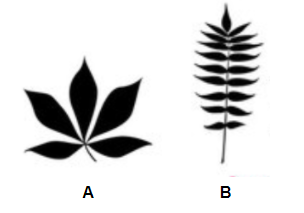
Identify the diagram A and B.

A) A= Palmate compound leaf ,B= Whorled phyllotaxy
B) A=Pinnate compound leaf ,B= Whorled phyllotaxy
C) A= Whorled phyllotaxy, B= Palmately compound leaf
D) None of these

Answer
474k+ views
1 likes
Hint: Leaves are classified into different categories based on how their lamina is divided. Lamina is also termed as the blade of the leaf.
Complete answer:
Let us first analyze the structure of the leaves given in the figure to identify them
Figure A: The leaflets of this leaf are radiating outwards from the point where the petiole of the leaf ends. Also, all the leaflets are originating from a single common point. The leaflets are clustered together forming a palm like structure and a joint is found between the leaflet and the point of its attachment. These characteristic features resemble that of a palmate compound leaf.
Figure B: In this figure more than two or three leaves are present at a single node.It shows whorled phyllotaxy leaf arrangement. These kinds of leaves are found in Alstonia plants. Other examples of whorled phyllotaxy include aspergula and nerium.
Option A: This option matches the above description and identification of the leaf in the figures. Therefore, this is the correct option.
Option B and C: These options do not match the above identification of figure A and B. Therefore, this is the incorrect option.
Option D: Since one of the above mentioned options is correct.Therefore, this is the incorrect option.
Thus, the correct answer is option (A) A= Palmate compound leaf, B= Whorled phyllotaxy.
Note:Pinnate compound leaves occur in two rows and no joint is found in them unlike palmate compound leaves. In alternate phyllotaxy, a single leaf is present at each node.
Complete answer:
Let us first analyze the structure of the leaves given in the figure to identify them
Figure A: The leaflets of this leaf are radiating outwards from the point where the petiole of the leaf ends. Also, all the leaflets are originating from a single common point. The leaflets are clustered together forming a palm like structure and a joint is found between the leaflet and the point of its attachment. These characteristic features resemble that of a palmate compound leaf.
Figure B: In this figure more than two or three leaves are present at a single node.It shows whorled phyllotaxy leaf arrangement. These kinds of leaves are found in Alstonia plants. Other examples of whorled phyllotaxy include aspergula and nerium.
Option A: This option matches the above description and identification of the leaf in the figures. Therefore, this is the correct option.
Option B and C: These options do not match the above identification of figure A and B. Therefore, this is the incorrect option.
Option D: Since one of the above mentioned options is correct.Therefore, this is the incorrect option.
Thus, the correct answer is option (A) A= Palmate compound leaf, B= Whorled phyllotaxy.
Note:Pinnate compound leaves occur in two rows and no joint is found in them unlike palmate compound leaves. In alternate phyllotaxy, a single leaf is present at each node.
Latest Vedantu courses for you
Grade 11 Science PCM | CBSE | SCHOOL | English
CBSE (2025-26)
School Full course for CBSE students
₹41,848 per year
Recently Updated Pages
Express the following as a fraction and simplify a class 7 maths CBSE

The length and width of a rectangle are in ratio of class 7 maths CBSE

The ratio of the income to the expenditure of a family class 7 maths CBSE

How do you write 025 million in scientific notatio class 7 maths CBSE

How do you convert 295 meters per second to kilometers class 7 maths CBSE

Write the following in Roman numerals 25819 class 7 maths CBSE

Trending doubts
State and prove Bernoullis theorem class 11 physics CBSE

What are Quantum numbers Explain the quantum number class 11 chemistry CBSE

Write the differences between monocot plants and dicot class 11 biology CBSE

Who built the Grand Trunk Road AChandragupta Maurya class 11 social science CBSE

1 ton equals to A 100 kg B 1000 kg C 10 kg D 10000 class 11 physics CBSE

State the laws of reflection of light




